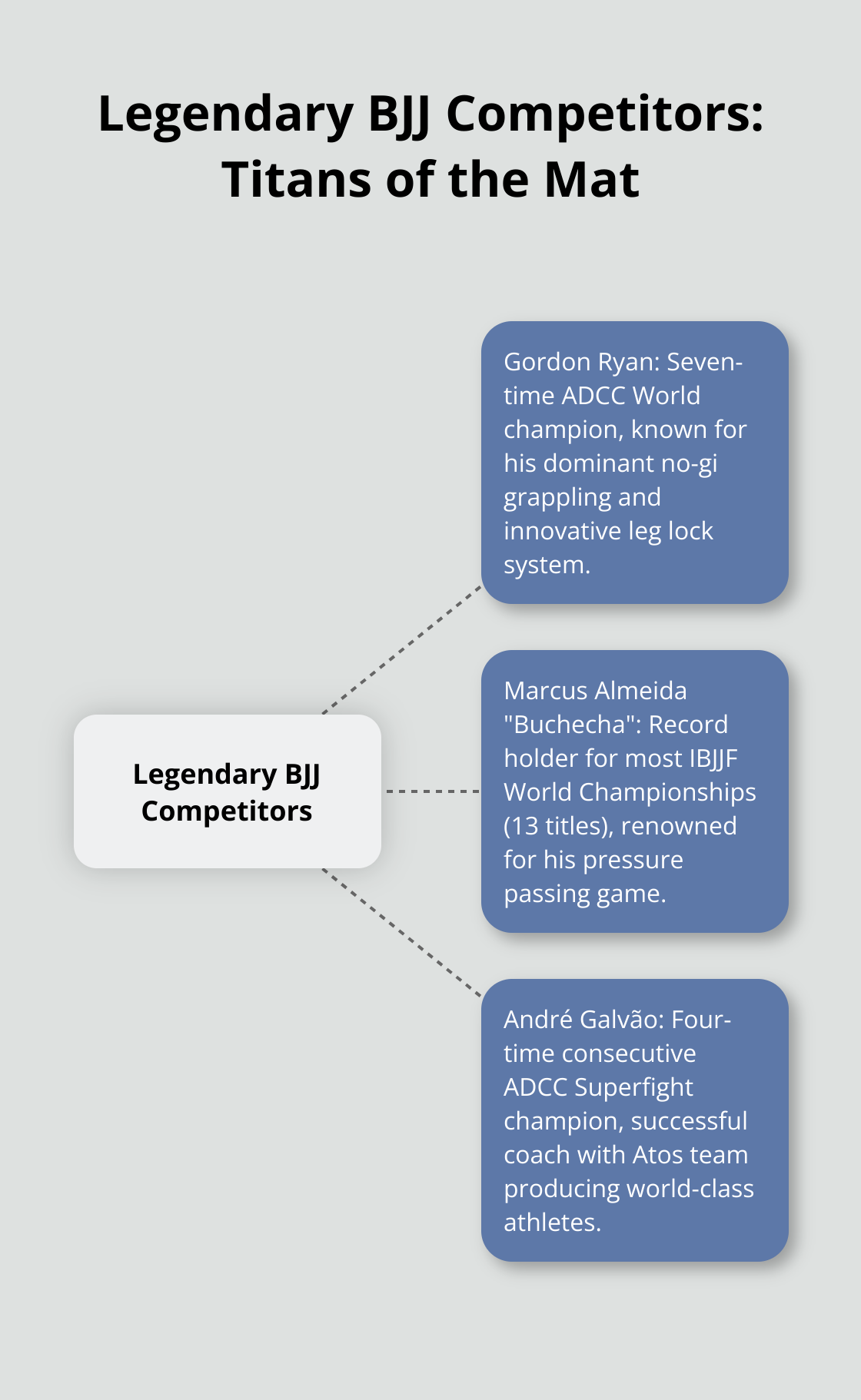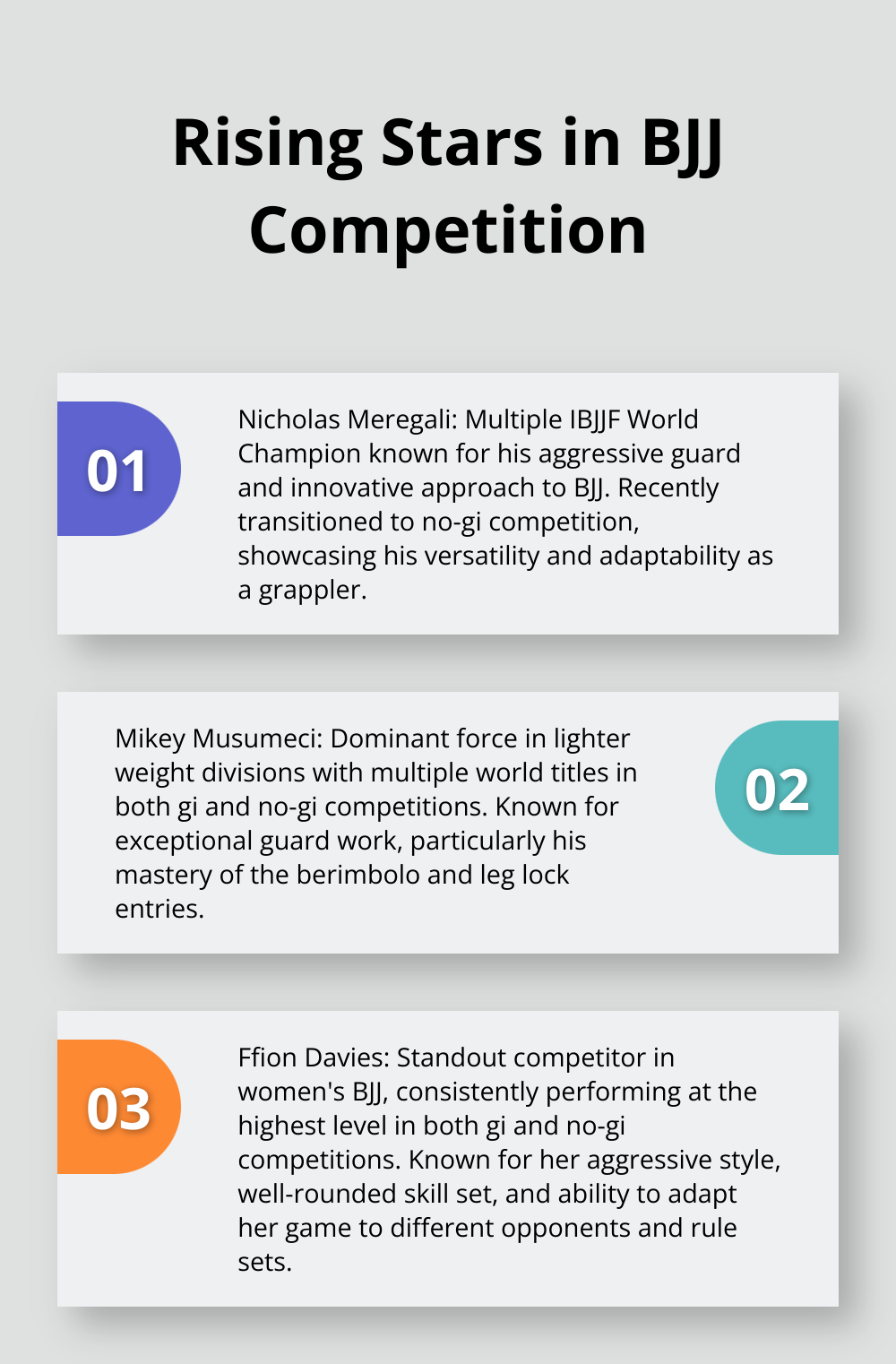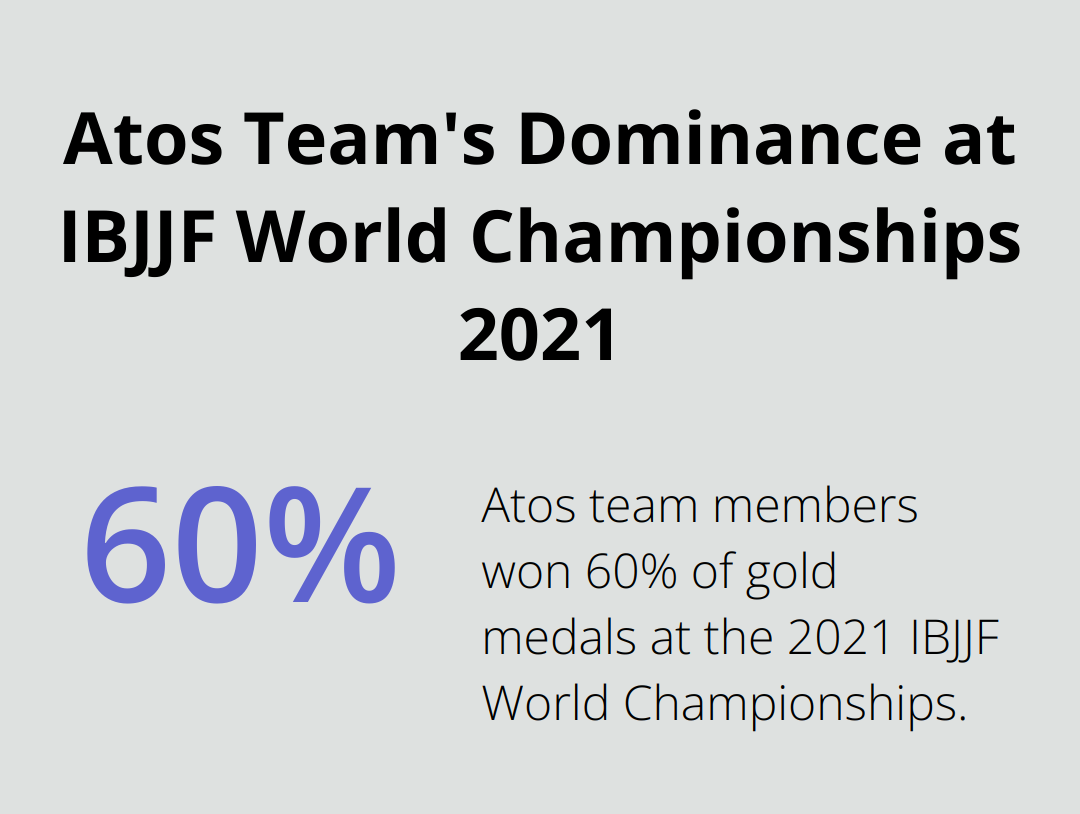At Jiu jitsu, we’re excited to explore the world of elite Brazilian Jiu-Jitsu competitors. From legendary champions to rising stars, these athletes shape the sport with their innovative techniques and unparalleled skills.
In this post, we’ll spotlight some of the best Jiu-Jitsu fighters, analyzing their signature moves and discussing their impact on the BJJ landscape. Whether you’re a seasoned practitioner or a curious newcomer, you’ll gain valuable insights into what makes these competitors truly exceptional.
Legendary BJJ Competitors: Titans of the Mat
Gordon Ryan: The Undisputed King of No-Gi
Gordon Ryan stands as the most dominant no-gi grappler of his generation. Born on July 8, 1995, this jiu-jitsu black belt from New Jersey is best known as a no-gi submission specialist and a seven-time ADCC World champion. Ryan’s leg lock system (particularly his heel hook entries) has forced competitors to adapt or face quick submissions.
Marcus Almeida “Buchecha”: Gi Grappling’s Greatest
Marcus Almeida, known as “Buchecha,” holds the record for the most IBJJF World Championships in history (13 titles). His dominance spans both his weight class and the absolute division, demonstrating his versatility against opponents of all sizes. Buchecha’s pressure passing game has become a blueprint for heavyweight grapplers worldwide. His recent transition to MMA further proves the effectiveness of high-level BJJ in mixed martial arts, with Buchecha securing submissions in all of his professional MMA bouts to date.
André Galvão: The ADCC Superfight Champion
André Galvão’s legacy in submission grappling shines through his unprecedented run in the ADCC Superfight. Galvão has won this prestigious match four consecutive times, defeating the world’s best grapplers. His ability to blend wrestling, Jiu-Jitsu, and physical conditioning makes him a complete grappler. Galvão’s success extends to coaching, with his Atos team consistently producing world-class athletes. In 2021, Atos members won 60% of the gold medals at the IBJJF World Championships, highlighting Galvão’s influence on the next generation of grapplers.
These legendary competitors have not only achieved personal success but have also elevated the entire sport of Brazilian Jiu-Jitsu. Their techniques, training methods, and competitive strategies continue to influence practitioners at all levels. Studying these champions’ approaches can provide valuable insights into what it takes to reach the pinnacle of the sport.

As we shift our focus to the rising stars in BJJ competition, we’ll see how these legends have paved the way for a new generation of grapplers who are pushing the boundaries of the sport even further.
Rising Stars in BJJ Competition
Nicholas Meregali: The New Guard of Gi BJJ
Nicholas Meregali has made a name for himself with multiple IBJJF World Championships. Known for his aggressive guard and innovative approach to BJJ, Meregali has become one of the most exciting competitors in the sport. His success stems from his relentless attack mentality and ability to create opportunities from seemingly disadvantageous positions.
Meregali’s recent transition to no-gi competition (a move that surprised many in the BJJ community) has further showcased his versatility and adaptability as a grappler.
Mikey Musumeci: Danaher Death Squad’s Lighter Weight Phenom
Mikey Musumeci has established himself as a dominant force in the lighter weight divisions. A former member of the Danaher Death Squad, Musumeci’s technical prowess and strategic mind have led him to multiple world titles in both gi and no-gi competitions.
Musumeci’s game features exceptional guard work, particularly his mastery of the berimbolo and leg lock entries. His ability to chain techniques together seamlessly often leaves opponents struggling to keep up. In recent years, Musumeci has also made significant strides in submission-only formats, further cementing his status as one of the most well-rounded grapplers in the sport.
Ffion Davies: Dominating the Women’s Division
Ffion Davies has emerged as a standout competitor in women’s BJJ, consistently performing at the highest level in both gi and no-gi competitions. Her aggressive style and well-rounded skill set have led to victories against some of the most established names in the sport.
Davies’ success can be attributed to her relentless work ethic and her ability to adapt her game to different opponents and rule sets. Her performances at ADCC and IBJJF events have not only earned her numerous titles but have also inspired a new generation of female grapplers to push the boundaries of what’s possible in women’s BJJ.
These rising stars represent the future of competitive BJJ, each bringing their unique styles and innovations to the sport. Their success serves as a testament to the ever-evolving nature of Brazilian Jiu-Jitsu and the endless possibilities for growth and improvement within the art.

To truly appreciate the impact these athletes have on the sport, we must examine the specific techniques that have made them so successful on the mats. In the next section, we’ll analyze the signature moves and strategies employed by these rising stars and established champions alike.
What Makes Top BJJ Competitors Unstoppable
At Souza Grappling Co., we believe in learning from the best. The techniques employed by top BJJ competitors offer valuable insights for practitioners at all levels. Let’s examine the signature moves that have propelled Gordon Ryan, Marcus Almeida “Buchecha,” and Mikey Musumeci to the pinnacle of the sport.
Gordon Ryan’s Leg Lock System
Gordon Ryan’s leg lock system has revolutionized modern no-gi grappling. His approach focuses on creating entanglements that limit his opponent’s mobility while exposing their legs to attacks. Ryan’s system builds on a foundation of solid positional control, particularly from the outside ashi garami position.
A key element of Ryan’s success is his ability to transition between different leg entanglements. He often starts with a basic single leg X-guard before progressing to more complex positions like the 50/50 or the saddle. This constant movement makes it difficult for opponents to defend effectively.
Ryan’s heel hook entries stand out. He uses a combination of hip movement and grip manipulation to expose his opponent’s heel, often finishing the submission before they can react.
Buchecha’s Pressure Passing Game
Marcus Almeida “Buchecha” has dominated the gi scene with his relentless pressure passing. His game builds on the principle of constant forward movement, using his weight and grip control to break down his opponent’s guard.
Buchecha’s passing sequence typically starts with a strong grip on the collar and pants. He then uses his hips to create pressure, forcing his opponent to react. As they defend, Buchecha capitalizes on any openings to advance his position. His ability to chain different passes together makes him particularly difficult to stop once he starts his passing sequence.
One of Buchecha’s signature moves is the over-under pass. He uses this technique to great effect against both seated and supine guards. By controlling his opponent’s hips and upper body simultaneously, he limits their ability to recover guard or create scrambles.
Musumeci’s Berimbolo and Back Takes
Mikey Musumeci has made a name for himself with his innovative guard work, particularly his use of the berimbolo to secure back control. His approach combines technical precision with a deep understanding of body mechanics.
Musumeci’s berimbolo game starts from a strong De La Riva hook. He uses this position to off-balance his opponent before initiating the spin. What sets Musumeci apart is his ability to maintain control throughout the rotation, often securing a seat belt grip before his opponent can react.
From the back, Musumeci excels at maintaining position and threatening submissions. He frequently uses the body triangle to limit his opponent’s movement, setting up his favored rear naked choke or bow and arrow submissions.
Understanding these techniques can significantly enhance your BJJ game. Souza Grappling Co. incorporates elements of these high-level strategies into our training programs, helping our students develop a well-rounded and effective grappling style.

Final Thoughts
The evolution of BJJ competition has transformed the sport from its Brazilian roots to a global phenomenon. Champions like Gordon Ryan, Buchecha, and Mikey Musumeci have redefined what it means to be the best Jiu-Jitsu fighter. Their innovative techniques and strategic approaches have elevated BJJ to new heights, influencing training methods and competition strategies worldwide.
Aspiring competitors can learn valuable lessons from these elite grapplers. Dedication, consistent training, and the development of a well-rounded game (with signature techniques) set champions apart. Adaptability also plays a key role in success, as top competitors adjust their strategies to different opponents and rule sets.
At Souza Grappling Co., we offer a range of classes and programs for practitioners of all levels. Our facility and instructors provide an environment for students to learn, grow, and push their limits. The world of competitive BJJ continues to evolve, with new stars emerging and established champions refining their games.




